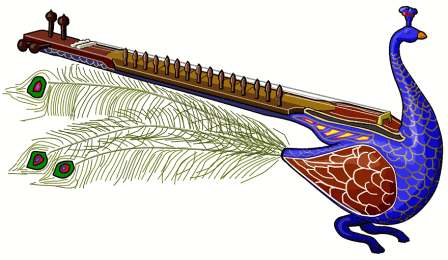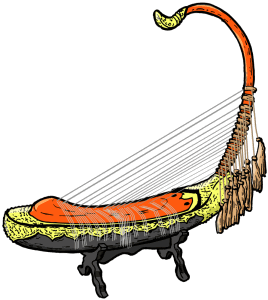User:ApeKattQuest, MonkeyPython/v*na: Difference between revisions
No edit summary |
No edit summary |
||
| (27 intermediate revisions by 2 users not shown) | |||
| Line 1: | Line 1: | ||
Veena or vina |
= Veena or vina = |
||
== Early history == |
|||
Initially used as a name for any chordophone, ancient "veena" were musical bows with increasing strings such as |
|||
these later developed into Harp veena like yazh and the burmese saung gauk.<br> |
|||
concordantly, short necked lutes originating from graeco-buddhist northwestern gandhara province. these where played standing but held variously, pearshaped pipa-like lutes appear in peninsular India, these were played sitting or standing. kaccapi vina is believed to be lute-type. |
|||
== Medieval Stick Zither == |
|||
Medieval Stick Zither type veena |
|||
Veena: |
Veena: |
||
| Line 11: | Line 19: | ||
<table border="1"> |
<table border="1"> |
||
<tr> |
<tr> |
||
<td> |
<td>Chikara [https://www.wikidata.org/wiki/Q5097384 wd] [https://en.wikipedia.org/wiki/Chikara_(instrument) en] [https://tickets.metabrainz.org/browse/INST-955 jira]</td> |
||
<td>http://web.archive.org/web/20191220143300if_/https://digitalstamp.suppa.jp/musical_instruments_c/chikara.jpg</td> |
|||
hindustani classical music, rajasthani folk sarangi, nepali sarangi [https://www.wikidata.org/wiki/Q7423131 wd] [https://en.wikipedia.org/wiki/Sarangi_(Nepali) en] MB!(?)<br> |
|||
sarangi type:<br> |
|||
kashmir (saran)<br> |
|||
south afghanistan (sarang)<br> |
|||
jammu (saranga)<br><br> |
|||
.type of lute, evolved from the rabab includes this and the ghaychak [https://www.wikidata.org/wiki/Q1521728 wd] [https://en.wikipedia.org/wiki/Ghaychak en] [https://musicbrainz.org/instrument/d50ba107-4930-4e0b-8b3f-ffbea4a1ade1 mb] [https://tickets.metabrainz.org/browse/INST-371 jira]<br> in its family evolved from the kobyz [https://www.wikidata.org/wiki/Q1778051 wd] [https://en.wikipedia.org/wiki/Kobyz en] [https://tickets.metabrainz.org/browse/INST-439 jira]. (kobyz, ghaychak, sarangi)<br> |
|||
<br></td> |
|||
<td>https://graphic.nobody.jp/musical_picture/sarangi_india_2.jpg</td> |
|||
</tr> |
</tr> |
||
<tr> |
<tr> |
||
<td>sarod</td> |
|||
<td>'''sarinda''' [https://www.wikidata.org/wiki/Q348878 wd] [https://en.wikipedia.org/wiki/Sarinda en] [https://tickets.metabrainz.org/browse/INST-856 jira], is related to and may derive from central asian shamans-fiddle qobuz (kobys?)<br> |
|||
<td>http://web.archive.org/web/20160511013835if_/https://saisaibatake.ame-zaiku.com/gakki/imgi/sarod_i.gif</td> |
|||
widespread:<br> |
|||
afghanistan, pakistan and north india (sarinda)<br> |
|||
: pakistani baluchistan (saroz)<br> |
|||
: iranian baluchistan (sorud (soruz)) derived from qobuz but more like indian types in use and construction, used for ritual<br> |
|||
: pakistani sind (surando) sindi and baluchi models have deeper upper bouts than sarinda<br> |
|||
rajasthan (surinda) three main strings<br> |
|||
Assam (sareja)<br> |
|||
: ''bengal (variant long necked svaraj)(belongs to sitar maybe?)''<br> |
|||
manipur north-east india (sananta)<br> |
|||
east & north india (banam)<br> |
|||
nepal (sarangi)<br></td> |
|||
<td>https://digitalstamp.suppa.jp/musical_instruments_s/sarinda.gif</td> |
|||
</tr> |
</tr> |
||
<tr> |
|||
<td>'''Sursingar''' [https://www.wikidata.org/wiki/Q2372387 wd] [https://en.wikipedia.org/wiki/Sursingar en] [https://musicbrainz.org/instrument/efca0287-2791-4209-b29b-1019891cb8d2 mb] hybrid plucked north indian classical lute invented c1800 by jaffar khan (seniya family)<br> |
|||
resonator, front and bridge from sitar, upperpart of neck/pegboard like the '''rabab''', tuned and played like '''rabab''', plectrum like sitar.<br> |
|||
(clearly this is a sitar/rabab hybrid)<br></td> |
|||
<td>http://web.archive.org/web/20200206002205if_/https://saisaibatake.ame-zaiku.com/musical/instruments/sursringar_i.jpg</td> |
|||
</tr> |
|||
<tr> |
|||
<td>'''sitar''' [https://www.wikidata.org/wiki/Q229205 wd] [https://en.wikipedia.org/wiki/Sitar en] [https://musicbrainz.org/instrument/9290b2c1-97c3-4355-a26f-c6dba89cf8ff mb] <br> |
<td>'''sitar''' [https://www.wikidata.org/wiki/Q229205 wd] [https://en.wikipedia.org/wiki/Sitar en] [https://musicbrainz.org/instrument/9290b2c1-97c3-4355-a26f-c6dba89cf8ff mb] <br> |
||
hindustani sitar seems to have more in common with large uzbek dutar [https://www.wikidata.org/wiki/Q1143814 wd] [https://en.wikipedia.org/wiki/Dutar en] [https://musicbrainz.org/instrument/b3cf8cff-f7c7-4311-bf4e-cfc09bdb07ca mb] than persian setar [https://www.wikidata.org/wiki/Q1544746 wd] [https://en.wikipedia.org/wiki/Setar en] [https://musicbrainz.org/instrument/f1299271-c5d7-4f7c-8b72-d64aa152c3bb mb]<br> |
hindustani sitar seems to have more in common with large uzbek dutar [https://www.wikidata.org/wiki/Q1143814 wd] [https://en.wikipedia.org/wiki/Dutar en] [https://musicbrainz.org/instrument/b3cf8cff-f7c7-4311-bf4e-cfc09bdb07ca mb] than persian setar [https://www.wikidata.org/wiki/Q1544746 wd] [https://en.wikipedia.org/wiki/Setar en] [https://musicbrainz.org/instrument/f1299271-c5d7-4f7c-8b72-d64aa152c3bb mb]<br> |
||
| Line 56: | Line 53: | ||
small sitar (kinnari veena)<br> |
small sitar (kinnari veena)<br> |
||
carnatic sitar<br></td> |
carnatic sitar<br></td> |
||
<td>https://digitalstamp.suppa.jp/musical_instruments_s/sitar.gif</td> |
<td>http://web.archive.org/web/20160417012026if_/https://digitalstamp.suppa.jp/musical_instruments_s/sitar.gif</td> |
||
</tr> |
|||
<tr> |
|||
<td>kachva sitar aka kacchapi vina</td> |
|||
<td>Cell 2</td> |
|||
</tr> |
</tr> |
||
<td>surbahar [https://www.wikidata.org/wiki/Q980383 wd] [https://en.wikipedia.org/wiki/Surbahar en] [https://musicbrainz.org/instrument/1ed558ad-1628-4e5f-8d14-e18e54375cd5 mb]<br> |
<td>surbahar [https://www.wikidata.org/wiki/Q980383 wd] [https://en.wikipedia.org/wiki/Surbahar en] [https://musicbrainz.org/instrument/1ed558ad-1628-4e5f-8d14-e18e54375cd5 mb]<br> |
||
| Line 62: | Line 63: | ||
<td>Cell 2</td> |
<td>Cell 2</td> |
||
</tr> |
</tr> |
||
<tr> |
|||
<td>'''Sursingar''' [https://www.wikidata.org/wiki/Q2372387 wd] [https://en.wikipedia.org/wiki/Sursingar en] [https://musicbrainz.org/instrument/efca0287-2791-4209-b29b-1019891cb8d2 mb] hybrid plucked north indian classical lute invented c1800 by jaffar khan (seniya family)<br> |
|||
<td>tanpura aka tambura aka tanpur (etc)</td> |
|||
resonator, front and bridge from sitar, upperpart of neck/pegboard like the '''rabab''', tuned and played like '''rabab''', plectrum like sitar.<br> |
|||
<td>http://web.archive.org/web/20140603224228if_/https://saisaibatake.ame-zaiku.com/gakki/imgi/tanpura_ia.gif</td> |
|||
(clearly this is a sitar/rabab hybrid)<br> |
|||
it has a sub-branch the sitariya (see sitar -_-)<br></td> |
|||
<td>https://saisaibatake.ame-zaiku.com/musical/instruments/sursringar_i.jpg</td> |
|||
</tr> |
</tr> |
||
<tr> |
|||
<td>Cell 1</td> |
|||
<td> |
<td>saraswati veena</td> |
||
<td>http://web.archive.org/web/20200206001410if_/https://graphic.nobody.jp/musical_picture/veena_saraswati.jpg</td> |
|||
</tr> |
</tr> |
||
<tr> |
|||
<td>Cell 1</td> |
|||
<td> |
<td>vichitra veena</td> |
||
<td>http://web.archive.org/web/20200206001415if_/https://graphic.nobody.jp/musical_picture/veena_vichitra.jpg</td> |
|||
</tr> |
</tr> |
||
<tr> |
|||
<td>Cell 1</td> |
|||
<td> |
<td>rudra veena</td> |
||
<td>http://web.archive.org/web/20200206001418if_/https://graphic.nobody.jp/musical_picture/veena_rudra.jpg</td> |
|||
</tr> |
</tr> |
||
<tr> |
|||
<td>Cell 1</td> |
|||
<td> |
<td>mohan veena</td> |
||
<td>http://web.archive.org/web/20200206001422if_/https://saisaibatake.ame-zaiku.com/musical/instruments/mohanveena.jpg</td> |
|||
</tr> |
</tr> |
||
<tr> |
|||
<td>Cell 1</td> |
|||
<td> |
<td>hansa veena<br> |
||
?(novelty)</td> |
|||
<td>http://web.archive.org/web/20200206001429if_/https://saisaibatake.ame-zaiku.com/gakki/imgi2/hansa_veena.png</td> |
|||
</tr> |
</tr> |
||
<tr> |
|||
<td>pulluvan veena [https://www.wikidata.org/wiki/Q55525195 wd] [https://de.wikipedia.org/wiki/Pulluvan_vina ge] mb!</td> |
|||
<td>http://web.archive.org/web/20200206001442if_/https://saisaibatake.ame-zaiku.com/gakkipedia/img/pulluvan-veena.gif</td> |
|||
</tr> |
|||
<tr> |
|||
<td>Cell 1</td> |
<td>Cell 1</td> |
||
<td>Cell 2</td> |
<td>Cell 2</td> |
||
</tr> |
</tr> |
||
<tr> |
|||
<tr> |
|||
<td>Cell 1</td> |
<td>Cell 1</td> |
||
<td>Cell 2</td> |
<td>Cell 2</td> |
||
</tr> |
</tr> |
||
<tr> |
|||
<td>Cell 1</td> |
<td>Cell 1</td> |
||
<td>Cell 2</td> |
<td>Cell 2</td> |
||
| Line 95: | Line 108: | ||
<table border="1"> |
|||
<br> |
|||
< |
<tr> |
||
<td>taus </td> |
|||
.....<br> |
|||
<td>http://web.archive.org/web/20191228042044if_/https://digitalstamp.suppa.jp/musical_instruments_t/taus.gif</td> |
|||
</tr> |
|||
< |
<tr> |
||
<td>mayuri-vina<br></td> |
|||
<br> |
|||
<td>http://web.archive.org/web/20191223221916if_/https://digitalstamp.suppa.jp/musical_instruments_m/mayuri_veena.gif</td> |
|||
< |
</tr> |
||
< |
<tr> |
||
<td>[[User:CatCat/yazh-yazhoo|yazh]]</td> |
|||
<td>http://web.archive.org/web/20191220095908if_/https://digitalstamp.suppa.jp/musical_instruments_y/yazh.gif</td> |
|||
<br> |
|||
< |
</tr> |
||
<tr> |
|||
+ lookup +<br> |
|||
<td>saung gauk</td> |
|||
taus mayerivina<br> |
|||
<td>http://web.archive.org/web/20200212130253if_/https://digitalstamp.suppa.jp/musical_instruments_s/saunggauk.gif</td> |
|||
veena<br> |
|||
</tr> |
|||
dhodro banam<br> |
|||
</table> |
|||
: kachva sitar<br> |
|||
: surbahar<br> |
|||
bin-sitar<br> |
|||
kamaica<br> |
|||
ravanhattha<br> |
|||
khuur (mongolian fiddles)<br> |
|||
<br> |
|||
<br> |
|||
'''svaraj''' fretless long necked plucked lute from bangladesj, it is a bangl version of the bengali/northindian dotara, it ought to be spelled saraj (see esraj) <br> |
|||
<br> |
|||
<br> |
|||
sara<br> |
|||
surs<br> |
|||
suba<br> |
|||
sita<br> |
|||
Origin: India, 13th century.<br> |
|||
Strings/Courses: 7/7<br> |
|||
Further notes: 3 drone strings, 5 melody strings, usually 12 sympathetic strings. Sympathetic strings are tuned depending on the raga being played. Steel strings.<br> |
|||
Scale Length: 680-870mm<br> |
|||
<br> |
|||
The Sitar is a Hindustani Classical Instrument. <br> |
|||
saro<br> |
|||
sari<br> |
|||
banam(rebs)<br> |
|||
<br> |
|||
<br> |
|||
'''rabab'''-> sarod<br> |
|||
<br> |
|||
How many r*b*b's do we have?:<br> |
|||
<br> |
|||
double chested '''rabab''' (pearshaped lute rubab)<br> |
|||
long-necked rabab (spikefiddle rebab)<br> |
|||
<br> |
|||
So:<br> |
|||
<br> |
|||
* spikefiddle, to wit the ghijak [https://www.wikidata.org/wiki/Q54995817 wd] [https://en.wikipedia.org/wiki/Ghijak en] [https://musicbrainz.org/instrument/0d766870-3021-47ce-bd51-78d2d2484e1b mb] and the [[User:CatCat/k*m*n*|kemenche]] belong... |
|||
* short necked fiddle boat-shaped (appears similar to double chested ones and may these pre-evolution) |
|||
* long necked barbed lute (pearshaped lutes?!) kamanche, ravaj, read vina |
|||
* double chested lutes, herein the sarinda and sarangi families. |
|||
<br> |
|||
https://timesofindia.indiatimes.com/From-Tri-tantri-Veena-to-Sitar/articleshow/21391436.cms and images on https://en.wikipedia.org/wiki/Tritantri_vina and https://en.wikipedia.org/wiki/Setar (compare image on https://en.wikipedia.org/wiki/Sitar ) makes it clear that it is the setar that is evolved from the tritantri veena - the sitar https://beta.musicbrainz.org/instrument/9290b2c1-97c3-4355-a26f-c6dba89cf8ff/ an unrelated (but possible distant cousin) was *named* after the Persian setar. |
|||
Revision as of 13:05, 12 February 2020
Veena or vina
Early history
Initially used as a name for any chordophone, ancient "veena" were musical bows with increasing strings such as
these later developed into Harp veena like yazh and the burmese saung gauk.
concordantly, short necked lutes originating from graeco-buddhist northwestern gandhara province. these where played standing but held variously, pearshaped pipa-like lutes appear in peninsular India, these were played sitting or standing. kaccapi vina is believed to be lute-type.
Medieval Stick Zither
Medieval Stick Zither type veena
Veena:
| Cell 1 | Cell 2 |
| Chikara wd en jira |  |
| sarod |  |
| Sursingar wd en mb hybrid plucked north indian classical lute invented c1800 by jaffar khan (seniya family) resonator, front and bridge from sitar, upperpart of neck/pegboard like the rabab, tuned and played like rabab, plectrum like sitar. |
 |
| sitar wd en mb hindustani sitar seems to have more in common with large uzbek dutar wd en mb than persian setar wd en mb
other sitar types: (distribution and related features suggest a common development)
sada sitar (plain or practice sitar) |
 |
| kachva sitar aka kacchapi vina | Cell 2 |
| surbahar wd en mb effectively a bass sitar. invented c1820 by ghulam muhammad |
Cell 2 |
| tanpura aka tambura aka tanpur (etc) |  |
| saraswati veena |  |
| vichitra veena |  |
| rudra veena |  |
| mohan veena |  |
| hansa veena ?(novelty) |
 |
| pulluvan veena wd ge mb! |  |
| Cell 1 | Cell 2 |
| Cell 1 | Cell 2 |
| Cell 1 | Cell 2 |
| taus |  |
| mayuri-vina |
 |
| yazh |  |
| saung gauk |  |